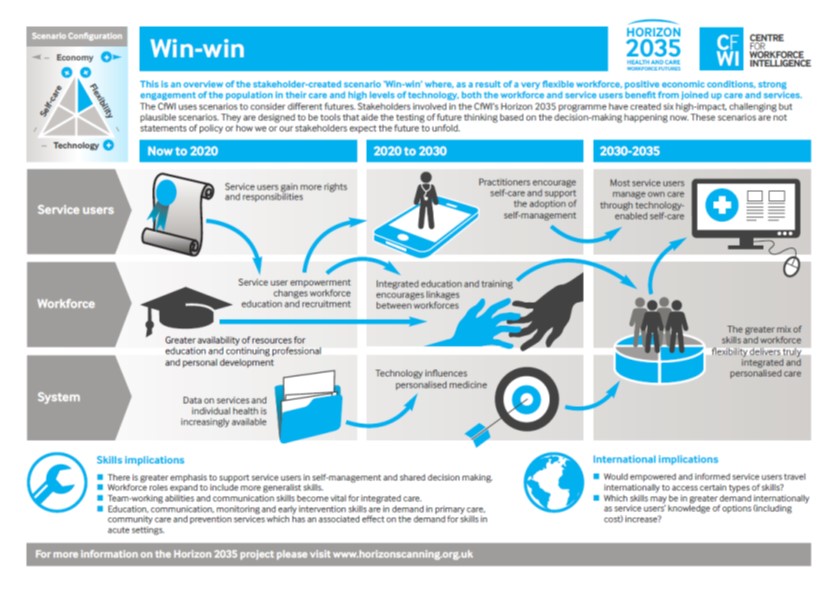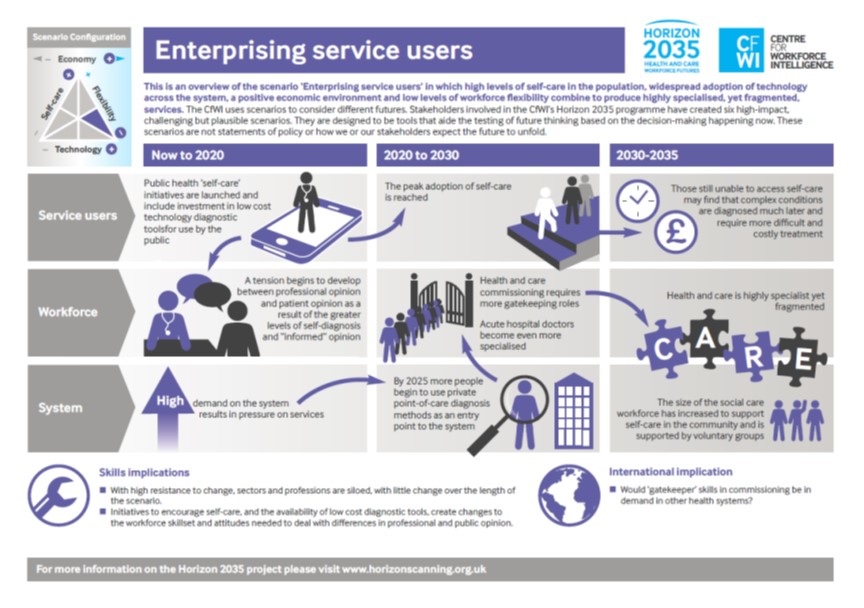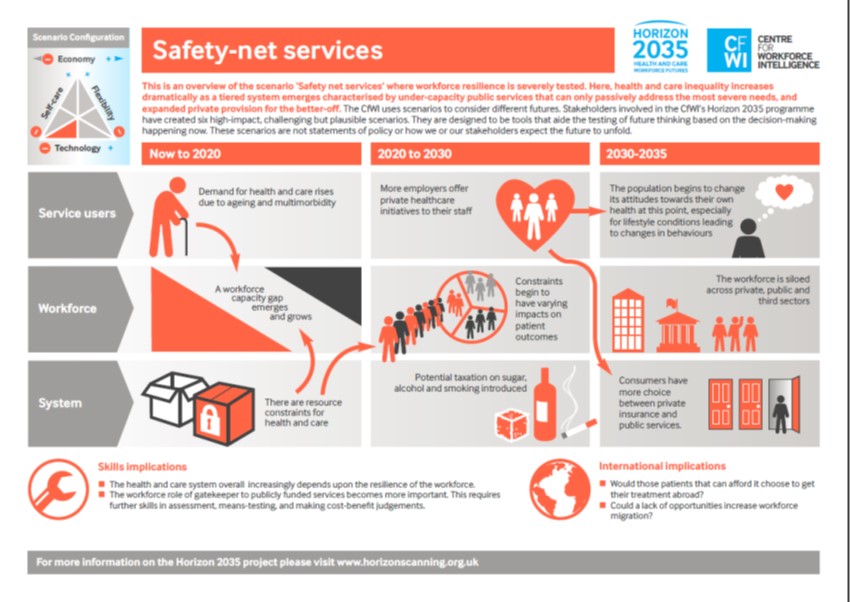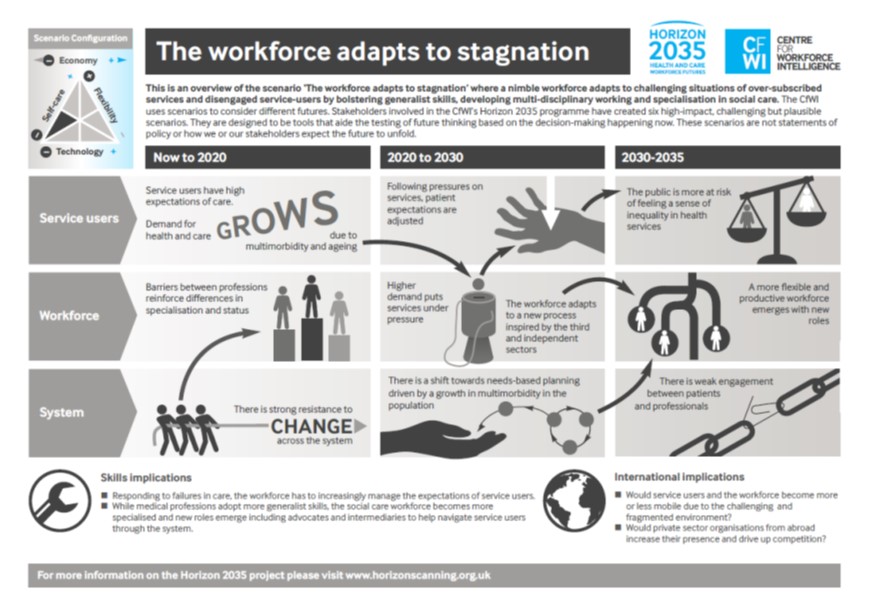Horizon 2035: the scenarios
Win-win |
Enterprising service users |
The professionals |
Safety-net services |
The workforce adapts to stagnation |
Inequality pervades |
This website is no longer maintained and content on this website will not be updated. Information on the website is accurate as of 26 February 2016. For any queries relating to this website or the CfWI, please contact workforceintelligence@dh.gsi.gov.uk and we will forward your message to the relevant colleague.
In our Horizon 2035 work we identified the most important influences on the whole workforce system – i.e. potential futures that might unfold and how these influences plausibly combine together to create scenarios.
We did this by collaborating with sector experts and stakeholders to prioritise the 29 most important system factors and then considering the direction they might take over a 20 year period. These outcomes were combined to create these 6 scenarios in a scenario generation event held during 2014.
Involving sector experts and stakeholders from across the health, social care and public health sectors. The four scenario dimensions chosen from the 29 most important factors by the participants were:
- The economy;
- technology level;
- workforce flexibility; and
- self-care.
Six scenarios were constructed using different, plausible directions and combinations of the four dimensions and these configurations are shown in the infographics below. These scenarios and their narratives are owned by the stakeholders who attended on the day. They are expressed in their own terms and we are currently considering the implications of these futures.
Common workforce themes emerging from the scenarios include modifying skill mixes to respond to these futures, changing responsibilities around demand, and the changing role of organisations and people across this system and the sectors within.
|
The Scenarios: |
||
|
|
As a result of a very flexible workforce, positive economic conditions, strong engagement of the population in their care and high levels of technology, both the workforce and service users benefit from joined up care and services. Click here to download the full graphic: http://cfwi.futuresdiamond.com/publications/horizon-2035-scenario-win-win/ |
|
|
|
High levels of self-care in the population, widespread adoption of technology across the system, a positive economic environment and low levels of workforce flexibility combine to produce highly specialised, yet fragmented, services. Click here to download the full graphic: http://cfwi.futuresdiamond.com/publications/horizon-2035-scenarios-enterprising-service-users/ |
|
|
|
High investment in technology and low workforce flexibility lead to a specialised but fragmented system. Overall population wellbeing decreases with service users unable to self-care and are frustrated by the level of complication in services. Click here to download the full graphic: http://cfwi.futuresdiamond.com/publications/horizon-2035-scenario-the-professionals/ |
|
|
|
Workforce resilience is severely tested. Here, health and care inequality increases dramatically as a tiered system emerges characterised by under-capacity public services that can only passively address the most severe needs, and expanded private provision for the better-off. Click here to download the full graphic: http://cfwi.futuresdiamond.com/publications/horizon-2035-scenario-safety-net-services/ |
|
|
|
Nimble workforce adapts to challenging situations of over-subscribed services and disengaged service-users by bolstering generalist skills, developing multi-disciplinary working and specialisation in social care. Click here to download the full graphic: http://cfwi.futuresdiamond.com/publications/horizon-2035-scenario-the-workforce-adapts-to-stagnation-2/ |
|
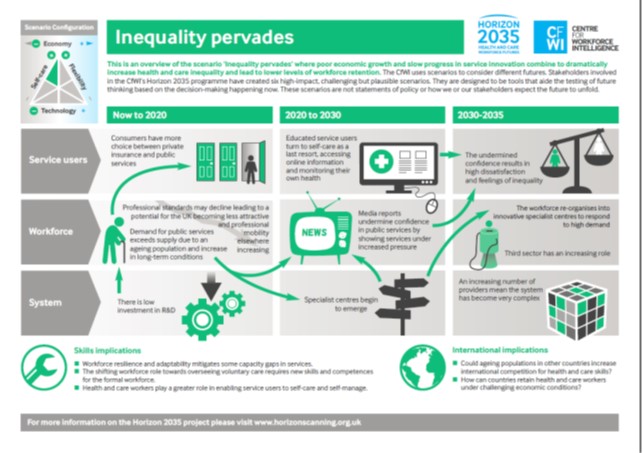 |
Poor economic growth, slow progress in service innovation and an inflexible workforce combine to dramatically increase health and care inequality and lead to lower levels of workforce retention. Click here to download the full graphic: http://cfwi.futuresdiamond.com/publications/horizon-2035-scenario-inequality-pervades/ |


